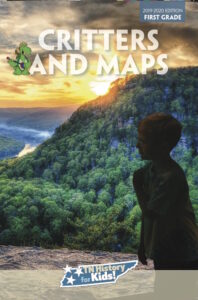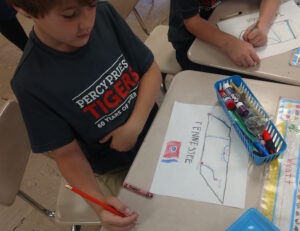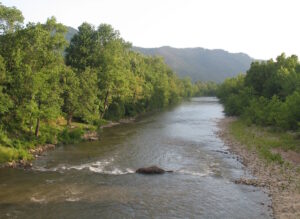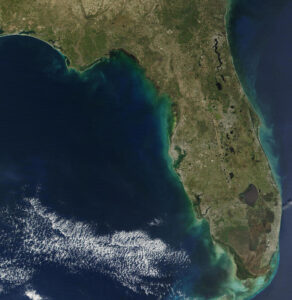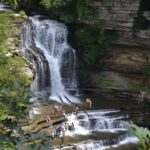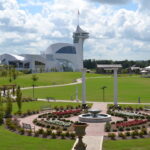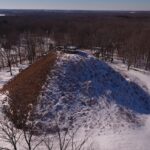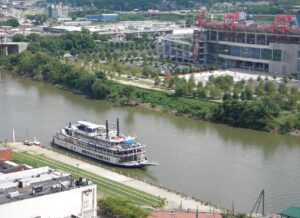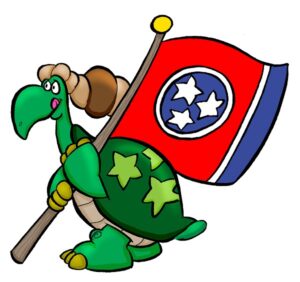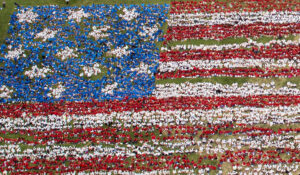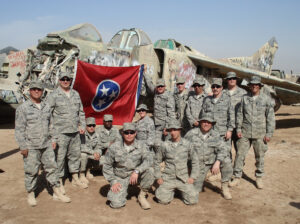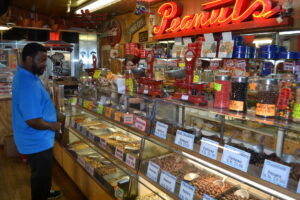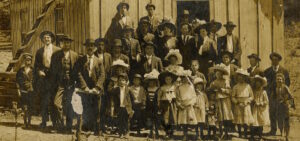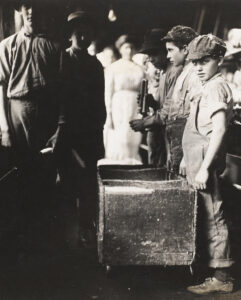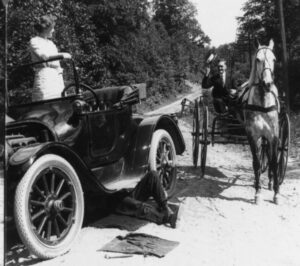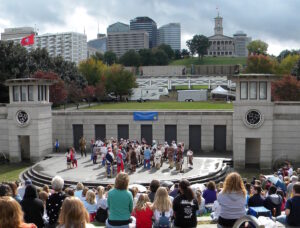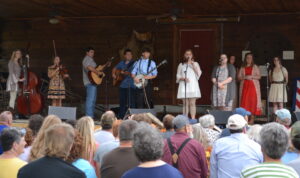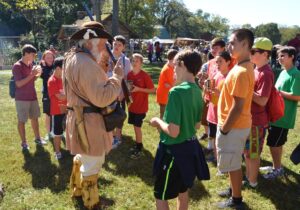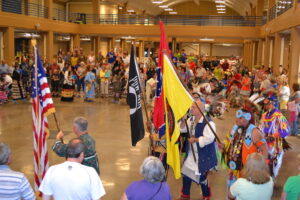Teacher’s Guide to Critters and Maps
Welcome to the teacher’s guide to the Tennessee History for Kids booklet Critters and Maps.
One of the reasons we have this online teacher guide is to show teachers (and students) MUCH larger versions of some of the photos that appear in the booklets. Sometimes, small photos don’t do it justice! So… if you click on the photos shown here, you’ll be shown a much larger version!
Please do NOT copy the booklets. That is a violation of our copyright and makes it difficult for us to continue to exist. The reason we sell them for only $2.50 and use paper that students can write on with a pencil is so teachers will not be tempted to copy the booklets.
If you have any comments about the booklet or would like the answers to the quiz questions in the booklet, please email Bill Carey at bill@tnhistoryforkids.org.
Cover
The cover photo was taken at the Tennessee Aquarium in Chattanooga. A boy is standing in front of a beautiful picture taken at Snoopers Rock, which is in Prentiss Cooper State Forest in Marion County.
Chapters One and Two
On the right is a photo of the Nolichucky River in Unicoi County. You can see clearly that the water is flowing downstream, as it does on all rivers.
It’s easy to take a photo of a lake, but lakes are so big that you really can’t take a photo that shows the whole thing. One of the most famous lakes in America is Lake Okeechobee, in Florida. On the left is a satellite image of the state of Florida, and you can see Lake Okeechobee in the Florida peninsula.
Chapter Three
There’s an Elementary Geography section on the Tennessee History for Kids website, and a lot of it supplements what is in this booklet.
Click here to check it out.
Chapter Four
 Click on the right to see a large version of the Grand Division map on pages 18-19.
Click on the right to see a large version of the Grand Division map on pages 18-19.
We are never able to put as many photos in these booklets as we like. Here are a few more landmarks in the Grand Divisions.
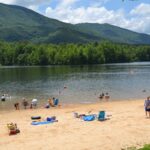
THFK photo
In East Tennessee:
In Monroe County, along the Cherohola Skyway, you will find a small lake with a sand beach (on the left).
 On the right is the town of Cumberland Gap, in Claiborne County. The town is named for the actual Cumberland Gap, which is a very important part of a trail that settlers used to travel through the mountains.
On the right is the town of Cumberland Gap, in Claiborne County. The town is named for the actual Cumberland Gap, which is a very important part of a trail that settlers used to travel through the mountains.
In Middle Tennessee:
Here, on the left, is Cummins Falls, in Putnam County. Even though this has only been a state park for a short while, it is already a very popular one, as you can see.
Here, on the right, is a view from atop the Cumberland Plateau. The photo was taken in Grundy County, but a lot of the land shown is in Coffee County.
In West Tennessee:
Here, on the left, is the Discovery Park of America, a wonderful museum in Obion County. Click here to learn more about it.
On the right is the largest mound at Pinson Mounds State Archaeological Area, in Madison County. Click here to be taken to a virtual tour of it.
Chapter Five
Your students may know that the football stadium in the photo on pages 24-25 is where the Tennessee Titans play.
Click on the image to the left to see a different view of the stadium.
Also, if you look closely you will see that the Memphis riverfront (page 26) is paved with stones. Why? Because the mud was so bad that people were sinking into the mud whenever they walked off riverboats. True story!
Click on the image of the right to see another view of the cobblestones.
The University of Tennessee football fans among us would love a larger version of the photo at the bottom of page 27.
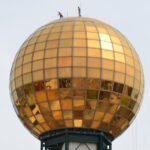 Speaking of page 27, take a close look at the photograph of the Sunsphere. Do you see the two men working on top of it? Click on the image on the right to see it.
Speaking of page 27, take a close look at the photograph of the Sunsphere. Do you see the two men working on top of it? Click on the image on the right to see it.
And here, on the left, is another version of the view of Chattanooga from Lookout Mountain.
Chapter Six
There are a LOT of official symbols of the state of Tennessee. The only ones listed in the standards are flag, tree, flower, bird, animal and state nickname.
However, Tennessee doesn’t have one state animal. It has about a dozen!
You see, Tennessee has an official sport fish (the smallmouth bass), an official commercial fish (the channel catfish), an official state bird (the mockingbird), an official state gamebird (bobwhite quail), an official wild animal (raccoon), an official horse (the Tennessee Walking Horse), an official amphibian (Tennessee cave salamander), an official reptile (eastern box turtle), 2 official state insects (the firefly and the ladybug), an official agricultural insect (the honeybee), and an official state butterfly (the zebra swallowtail).
In fact, I’ve always thought it would be interesting if we put one example of all 12 state animals in a small room, then closed the door. (My money’s on the raccoon; those critters have a mean streak!)
There are also NINE official state songs. So please don’t tell your students that Rocky Top is “the” official state song, because there are eight others.
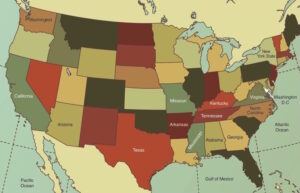 Chapter Seven
Chapter Seven
Click on the image to the right to see the map on page 36. You may notice that 13 states are identified in this map, including Tennessee, all the ones that border Tennessee, Texas, California, Washington, New York and Arizona.
Not all of these are required in the first grade standards. However, third grade teachers would be very appreciative if you taught your first grade students some of these states.
The Pledge of Allegiance is discussed in this chapter. Here are some things that you may not know about the pledge:
* It was written in 1892 by Francis Bellamy, the former pastor of the Bethany Baptist Church in Boston, Massachusetts. Bellamy wrote it for a magazine called Youth’s Companion, which was looking for ways to commemorate the 400th anniversary of Columbus’ landing in America.
* The words “one nation, under God” were added in 1955, at the request of President Dwight Eisenhower.
* Today, people put their hands over their hearts while saying the pledge. But, originally, the accepted salute to the United States flag (now known as the Bellamy Salute) consisted of a person holding out their right hands, as shown in the photo on the left. During World War II, Congress changed the Pledge of Allegiance salute because it was so similar to the Nazi salute.
The photograph of Fort McHenry on page 40 features 6,600 students wearing red, white and blue T-shirts and arranged in the shape of an American flag. To see this better close up, click on the image on the right.
Chapter Eight
If you click here you will find the 95 Tennessee county history pages.
On those pages you will find (among other things) photos of every courthouse in Tennessee!
Chapter Nine
Please explain the difference between Veteran’s Day, Memorial Day and Independence Day. In recent years, the holidays have become blended, and U.S. veterans sometimes feel left out of the patriotic celebrations that take place. Many college and professional sports teams, for instance, will have a “Military Service Day” around Veterans Day on which veterans are actually never honored.
So, here is an idea for two good questions:
1) What is an appropriate action on Memorial Day? Decorating the graves of military veterans
2) What is an appropriate action on Veterans Day? Asking a veteran what he or she did in the service
Chapter Ten
The community service projects shown on page 56 are wonderful, and there are many more. Please consider asking your students to take part in a community service project or, even better, organizing one.
Chapter Eleven
This is a good time to acknowledge that all the cartoons in this booklet were created by Rick Baldwin, who used to work with me at the Metro Pulse newspaper in Knoxville.
Yes, that’s Boxy the Turtle with a hula hoop, a basketball, a stuffed animal, a car, a skateboard and a castle.
The candy store photographed on page 59 (shown on the right) is the Nashville Nut, in the Downtown Arcade.
The toy store photographed on page 61 (shown on the left) is Phillips Toy Mart in Nashville.
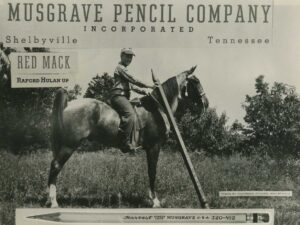 Chapter 12
Chapter 12
You may wonder about the photograph on page 64 of the woman working at a pencil factory. It used to be that so many pencils were made in Shelbyville, Tennessee that it became known as “Pencil City U.S.A.”
Click here for the story behind this, and a quick tour of the Musgrave Pencil Factory.
Chapter 13
The photograph on page 72 features a family reunion at the Wessyngton Plantation in Robertson County. If you don’t know the story about the Wessyngton Plantation and how one man’s research has helped thousands of people trace their ancestry, it really is something. Click here to read a Tennessee History for Kids tour “In Search of Family, Wessyngton and Slavery.”
Chapter 14
There are some pretty amazing photographs in this chapter. Click on the images to make them larger.
The photo of boys working in a factory in Fayetteville is one of many which was taken by photographer Lewis Wickes Hines, who took many famous photos of children working in factories and coal mines all over the United States.
The photo on the right, which shows one man working on a car while another one drives by in a horse and buggy, is just funny. I suspect your students can find many thing that have changed since this photo was taken.
Finally, we aren’t kidding about the row of outhouses being near the Tennessee State Capitol in the 1950s. One of the first urban renewal projects in the United States was one that cleared an area of houses such as these on the north and west sides of the Tennessee State Capitol.
Chapter 15
The main point that I am trying to make in chapter 15 is that the word “culture” should not just mean cultures other than the ones we already have in Tennessee. There is culture all over the place–we just don’t use that word very often.
I do think that some of the photographs look great blown up, so here are a couple of them:
* Above right: This photo was taken at one of the Tennessee History Festivals which is put together by the Bicentennial Capitol Mall State Park every October. At this particular festival, the outdoor drama “Liberty” was presented.
* The photo on the left was taken at one of Scott County High School’s Heritage Festivals. Every high school principal in Tennessee should go see all the amazing things that they have done at Scott County High School–with all the museums on the grounds and all the events that occur there.
Chapter 16
Again, some really cool photos:
* If you haven’t been to the Museum of Appalachia in Anderson County, you really, really need to go.
* I’m partial to the Indian Creek Productions Powwow in Jefferson County (on the left) which is put on by Mark and Sherry Finchum, both educators
